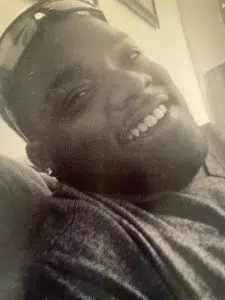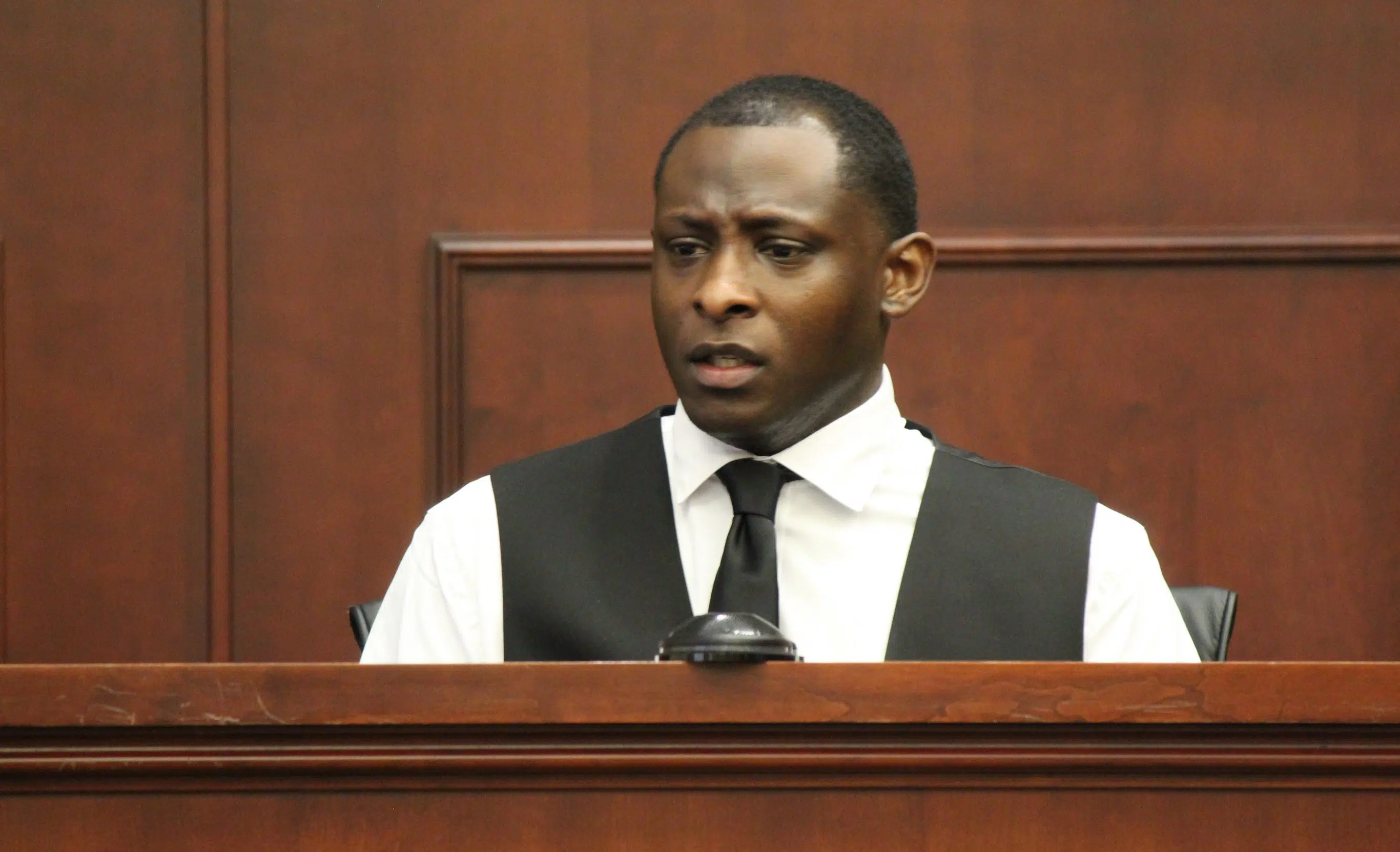BY MELINDA J. OVERSTREET
FOR GLASGOW NEWS 1
On the third and final day of testimony in the trial in which Inell Crayton is charged with murder, two people took the witness stand – a forensic scientist who called into question the Kentucky State Police’s documentation and preservation of the crime scene and/or evidence and, second, the defendant himself.
Crayton also faces charges of first-degree burglary and tampering with physical evidence, with all three accusations related to the fatal shooting of Ke’Shawn Sarver, 22, of Cave City in the apartment he shared with his mother, who was at work the evening of the events in question.

Ke’Shawn Sarver
When Crayton took the stand, he recounted essentially the same information his original co-defendants and another person involved had when they testified Wednesday about how he came to be at Sarver’s apartment. He, his girlfriend Kayla Anderson and his friend Devonja Sweat traveled to Cave City to purchase some marijuana from Sarver for $1,600, which was money the three of them had pooled, and when they arrived at Sarver’s apartment complex, he approached and got in the car and directed them to the driveway entrance of a house and told Anderson, who was driving, to turn off the lights and all them to stay in the car because the seller’s parents who also lived there didn’t know of his dealings.
Crayton gave the money to Sarver, who met up with someone near the house but then disappeared from sight and did not return. Several minutes later, Crayton got out and went up the hill and found no one then returned to the car to see whether Anderson had heard anything from her attempts to contact Sarver, and she had not. He told Sweat to stay with Anderson and went back up the hill but Sweat followed and they realized Sarver’s apartment complex was across a field down the hill from the back side of the house. Sweat went first and called Crayton to confirm it was indeed the same complex, and Crayton called Anderson to tell her to stay put in case Sarver came out of the house, but she had seen a woman looking out the window of the home and decided it was best to leave.
Crayton knocked on the door closest to where he’d seen Sarver emerge when he first got in the car and a dog was barking in the window, but there was no other response from the dark apartment, then he and Sweat looked around the complex for Sarver and asked a few people and learned which apartment was Sarver’s and started knocking there again and eventually sat in a chair on the porch to wait for Sarver.
“I just wanted to get my money back so I could go home,” Crayton said, noting he had worked a full day earlier and was tired.
At some point the dog’s movement in the window moved the blinds enough that Crayton could see in the apartment a little and thought he saw a nightlight but then he looked over and saw a human figure with a cell phone that kept lighting up in one hand.
The confrontation
“So I got mad, angry, and kicked in the door,” Crayton said. “My gun was still in my pocket holster in my right pocket. … Once I stepped in, Ke’Shawn, like, raised his arm and I noticed there was something in his hand but I couldn’t, you know, tell what it was. I thought it was a machete. He started swinging at me like this, you know, yelling, ‘Get back!’ After he was swinging, I was rolling to my right trying to move, dodge, you know, what I thought was a machete.”
In that process, he began reaching for his gun to try to protect himself, he testified. He said he fired a shot but wasn’t sure whether he had hit Sarver because he was still coming at him, and he fired a second shot. It was still dark in the apartment during this time.
“Sweat somehow managed to end up in front of me, and the dog, from what I remember, the dog ended up jumping on him while I was trying to run out of there, trying to make my way back toward the door,” Crayton testified, adding that he felt Sarver was trying to kill him. “I remember shooting at the dog once before I ran out. I wasn’t sure if the dog was shot or Ke’Shawn was shot. I didn’t know if I hit Ke’Shawn or where he was.”
He ran out and looked back once to see whether Sweat or Sarver was behind him and neither was.
Davis asked him about his giving a different account to police earlier and Crayton said everything had happened so fast, his mind was kind of scrambled.
“It was never my intention to harm anybody,” Crayton said. “When I made the statement with police, I tried to explain what had happened when I was there. I tried to be honest, thought I was.”
Davis asked him about one discrepancy in his statements in particular.
“When the detective was saying something about that you had advanced on him and stood over him and shot him,” Crayton said, “at first, in that recording that you all heard yesterday, I was stating that I wasn’t sure.”
He said the detective kept repeating it and putting pressure on him “until I agreed to something that I shouldn’t have. I was distraught, you know. Like I said, I was broken from it, you know, from everything that happened. I felt very responsible.”
Davis asked directly, “Did you stand over and shoot him?”
“No,” Crayton said.
The defendant said Sarver kept swinging at him and he “fired back in self-defense.”
Davis asked about how long he was there in Sarver’s apartment, and Crayton said he really couldn’t put a time stamp on it.
“It happened fast,” the defendant said.
He said he ran out of there and called Kayla to get him, and then they picked up Sweat after Crayton called him. They headed back to Allen County, where Anderson and Crayton were living together and where Sweat was visiting overnight from Nashville. On the way back, Sweat told Crayton to give him the gun and he did so without asking why, and Sweat asked Anderson to take the safety lock off the window. Crayton said he knew Sweat had thrown something out the window but he didn’t know it was the gun until after they got back home.
“I wasn’t sure what happened. I wasn’t expecting anything to happen like that,” Crayton said, adding it had never been his intention to hurt anyone.
He had said in his interview with detectives, according to the videorecording, that he wanted to give Sarver a “whooping” for taking the money.
Dec. 28, 2018, was on a Friday, and on Sunday he disposed of his shoes in Bowling Green when he went there to work, he said.
Gardner said he wanted to get one thing straight right off the bat when it came time for him to cross-examine Crayton, and that was that he was the one who fired all the shots in the apartment that night. Crayton said that was true for the time he was in the apartment.
“Anything after that, I don’t know,” the defendant said.
Gardner said Crayton had a few days to think about what had happened by the time KSP went to their home in Allen County, and Crayton said he still didn’t really know at that point what had happened, and he had actually tried not to think about it, but he also hadn’t had much sleep in the interim.
“At the time I made that statement, I wasn’t in my right mind,” Crayton said.
Gardner asked several questions pointing out discrepancies between the police interview and his testimony.
Expert witness
Eric Warren, a forensic scientist who started SEP Forensic Consultants after working with the Tennessee Bureau of Investigation for about nine years, had been contacted by an attorney who was working on Crayton’s defense earlier in the case, he testified. Unlike the KSP firearms-expert witness who testified on Wednesday who had only been provided with physical evidence itself such as bullets and casings, Warren said he was provided with crime scene photos, supplemental reports from investigators about what was done at the crime scene and such, the KSP lab report and the autopsy report for analysis.
Lee Davis, Crayton’s attorney, asked Warren how he thought this case had been handled.
“Based on my training and experience and what I train other people to do, there was very – the investigation was lacking,” he said. “There are things I would have suggested and would like to have seen done to be able to get us all of those data points that we would need, or that I would need as a crime-scene reconstructionist, to actually be able to reconstruct or determine the order of events that would have occurred.”
Examples of the things he considered potentially problematic were that there was zero documentation that anyone changed their gloves between handling different pieces of evidence; that at least one investigator was not wearing shoe coverings at the scene; that at least one was not wearing gloves and another was wearing fabric gloves; that no trajectory rods were used to determine the path of the bullets; that no examination of the dog that was also fatally wounded other than an x-ray was conducted; no DNA testing was conducted; and that the removal of the bullets from the refrigerator, shower and floor may not have been done in a manner to best preserve the bullet – or in the floor, the fragments of one – or to preserve that entry site. In addition, no diagrams were created nor measurements taken to document the distance of items and the body among themselves. He said photographs should be taken from every corner of every room, and for each piece of evidence, there should be long-range, midrange and close range photos, best on established best practices, and these things were not done in this case.
In Warren’s opinion, the bullet entry point in the floor near where Sarver’s body came to rest was not the one that went through his neck and out the middle area of his upper back, and it wasn’t necessarily fired straight down, as investigators had believed.
Commonwealth’s Attorney John Gardner said Crayton admitted to firing all the shots, and Warren said that human cognition and memory have too many issues to be entirely dependable, particularly in situations where adrenaline is rushing, so he would not rely on a statement like that for his conclusions.
“As individuals, when you go through a situation like that, there’s not a high accuracy in recounting what actually occurred, so my conclusions would be based on science,” Warren said.
Gardner said the “trajectory analysis and all of that” wouldn’t determine who actually fired the shot, though, and Warren countered with, “It absolutely could determine, yes.”
The prosecutor asked other questions as well, some of which were clearly intended to reduce any potential impact of Warren’s testimony in other ways.
The trial is expected to conclude Friday with closing arguments and instructions to the jury before they are given the case to deliberate. The proceedings are to begin at 8:30 a.m. in Barren Circuit Court.
— NOTE: For the sake of brevity and clarity, many instances of “um,” “like” and “you know” used by Crayton were removed in this report. Otherwise, what is within quotation marks is exactly as heard in court.

Comments